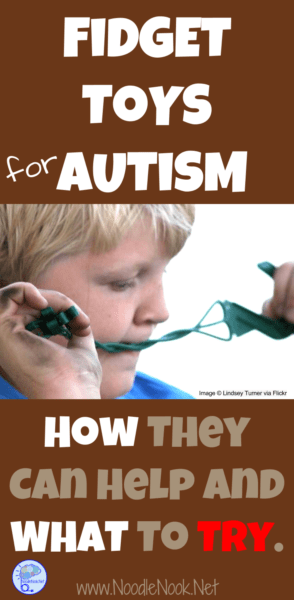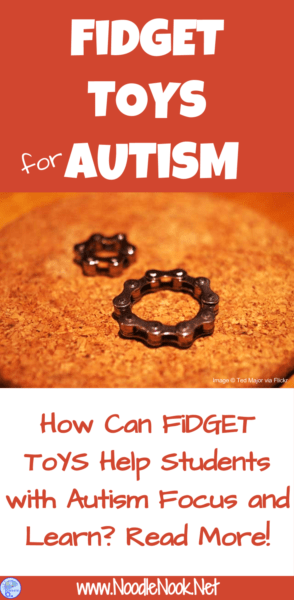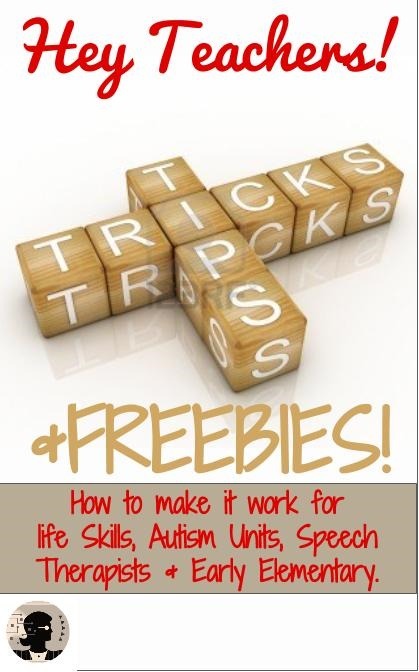I was in a classroom a few years ago and the student was like the ball in a pinball machine! He was up and moving during my entire observation. There were moments where he could be cajoled into sitting and attending to a task, but they were few (very few), far between, and super short. The teacher looked at me needing help. Her job had become an exhausting workout.
I left and came back the next day with a few ideas and some fidget toys. Guess what… it helped.
Why Use Fidget Toys in Autism Units?
First off, please click over to the article Why Do Kids with Autism Do That? It has a lot of information that helps to understand the motivation behind the behaviors of kids with Autism.
A fidget toy is a great self-regulation tool that actually helps focus, calm, and help a with attending. In studies of students without Autism, using a fidget toy during lectures actually helped them retain information… so fidgeting isn’t just for students with Autism. The fact of the matter is the act of squeezing, pushing, pulling or moving a small fidget object can help get a student to sit and listen. It is a great physical outlet allowing the brain to focus. An adult constantly telling a student to sit down, chasing after a student to get them back to their seat, or getting upset with them when they destroy property only serves to increase anxiety, increase behavior, and decrease task completion.
There has to be another way… and there is!
[tweetthis]Fidgeting in the Classroom for Students with Autism. Read More![/tweetthis]
As you know, people with Autism often have sensory processing issues. It is not unusual to see a student with Autism rocking, humming, flapping, or picking at their lips, hair, or scabs. Part of that is because their senses are being inundated with tons of messages- lights, voices, sounds, smells, even the air blowing over their skin. The behavior is there to drown out the sensory overload. The behavior helps to focus. So adding a sensory tool, like a fidget, helps to quiet the noise and focus the brain.
Options of Fidget Toys for Autism or Attending
I really want to reiterate that fidgets work for students with Autism… but they also work for so many more. Students with ADHD can benefit from fidgets, kids with lots of energy to burn can benefit, or those who you just find need a lot of redirection.
DIY Fidgets: When it comes to making it all work on a teacher’s budget, you may want to go the route of DIY or items that can serve a dual purpose.
- Rice in a Balloon. I used to make these all the time- super easy and the right size for student hands. I have also used flour, oatmeal, and popcorn kernels- students will like different ones for different reasons, but they all get you the same results. Looking for a step-by-step DIY? Check out my Pinterest Board https://www.pinterest.com/noodlenook/social-skills-behavior/ to find some great tutorials and visuals on several DIY Fidgets.
- Glitter Bottles: Also an easy make. I used old water bottles and had great success. Just be sure to use a thicker bottle and also glue the top on. Again, check out my Pinterest board for tutorials and visuals.
- Foot Fidgets: Fidgets aren’t just for hands and fingers. You can make a foot fidget by putting a bungee cord through a pool noodle (cut to size) and attaching it to the student’s chair. Perfect for focusing attention and keeping the body moving.
- Moving Chair: A yoga ball, rocking chair or swivel chair all make great tools to harness the fidget. The student I mentioned in the beginning of the post was able to sit for extended periods from 30-40 minutes once he was allowed to sit in a yoga ball style chair. He literally went from sitting maybe 20 minutes for an entire school day to sitting for multiple sessions of 30-40 minutes. It was the sensory redirection he needed to focus and work. He eventually ended up with a specialized yoga ball chair, but that was after he started on just a regular yoga ball.
- Store Bought Items: These include things like silly putty, koosh balls, rubber band balls, wine corks, and even hot wheels cars (the wheels on the car can serve as a great soothing fidget).
Specialized Fidgets: Yeah, there are fidgets made specifically as fidgets… and if you find that fidgets really help to redirect your student, investing in a good one may be worth the extra money. This collection from Amazon can work for lots of students, so try one or more and see what is the most effective.
Fidget toys can also include Chewelry or even hard candy and gum if a student has oral sensory needs. Be sure to check out the post on Licking in Students with Autism for more.
And remember, you want to change out fidgets frequently. Their ‘magic’ can wear off as a student gets bored with certain items. Conversely, a student can find a favorite in which case you may want to invest in a few more in case one gets lost or broken.
Happy Teaching and Fun Fidgeting!
This post contains affiliate links. As an affiliate seller, I receive a small commission when you purchase through the link.





